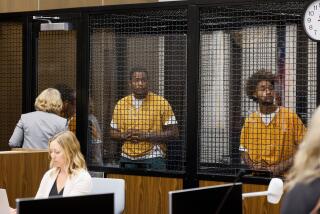Thinking Like a Juror : The scales of justice overbalance to favor the prosecution or the defense : FATAL JUSTICE: Reinvestigating the MacDonald Murders, <i> By Jerry Allen Potter and Fred Bost (W.W. Norton: $25; 463 pp.)</i>
- Share via
Twenty-five years before th O.J. Simpson trial, there was the Jeffrey R. MacDonald case.
Early on the morning of Feb. 17, 1970, the Green Beret surgeon made a frantic call to an operator from his home on the Ft. Bragg Army base in North Carolina. Army investigators arrived to discover the stabbed and bludgeoned bodies of MacDonald’s pregnant wife Colette, and the couple’s two young daughters, Kristen and Kimberly.
MacDonald, too, sustained numerous wounds, though their severity depends on whether defense or prosecution experts are describing them, as does the issue of whether they were likely self-inflicted.
The truth of what happened is known only to MacDonald. He says that three men and a woman with blond hair, a short skirt and a floppy hat broke into his home and slaughtered his family. An army hearing ruled against prosecuting MacDonald. But nine years later a civilian jury convicted him of the first-degree murder of Kristen and second-degree murder of Colette and Kimberly. MacDonald has maintained his innocence, insisting that all the evidence has not been heard.
For 25 years, MacDonald’s name has spiraled through the American consciousness. In 1983, after the civilian trial, author Joe McGinniss condemned MacDonald in his best-selling book “Fatal Vision.” That book led to a television movie as well as a critical examination of McGinniss’ own character and journalistic ethics by author Janet Malcolm (“The Murderer and the Journalist”).
Now, Jerry Allen Potter and Fred Bost’s “Fatal Justice: Reinvestigating the MacDonald Murders,” raises new questions about the convoluted case, stirring new buzz on the talk-radio waves.
Documents the authors obtained through the Freedom of Information Act, for instance, show that fingernail scrapings, reportedly taken from under Colette MacDonald’s nail, disappeared from the evidence before analysis. The record reveals that blond synthetic fibers, perhaps from a wig, were found in a brush in the MacDonald home and never fully explained.
The authors point out other discrepancies and alleged conflicts of interest. For example, Franklin T. Dupree Jr., the judge who presided over the grand jury that sent MacDonald to trial, who presided at MacDonald’s civilian trial and who heard his district court appeals, turns out to have been the father-in-law of James Proctor, the zealous assistant U.S. attorney who took on the MacDonald case after the Army refused to prosecute.
The most perplexing twist in MacDonald’s trials has come from interviews with Helena Stoekley, a Fayetteville “hippie” and police informant known to abuse drugs, wear blond wigs and dabble in the occult, who, at various times before her death, confessed that she believed she was in the MacDonald home at the time of the murders. For various reasons--sinister or common-sensical, depending on whose side you’re on--the courts never considered Stoekley credible.
“Fatal Justice” rounds up new witnesses and evidence that lend credence to Stoekley and support MacDonald’s account of events. Yet there comes a point in any case, when theories should be poured through the logic-sifter known as “Occam’s razor.” That 13th-Century principle of intellectual economy might be paraphrased: The simplest explanation is the most likely.
If an intricate explanation of some event is to be believed, it had better be laid out clearly and precisely. Unfortunately for readers, and for MacDonald, “Fatal Justice” is awkwardly organized, repetitive and unpersuasive. It lacks the authority and precision of pure just-the-facts-ma’am journalism; it lacks drama, character analysis and insight.
The book is written by Potter in the first person, with confusing references to Bost. When Potter turns writerly, it’s bad Raymond Chandler contest time. In an early scene, for instance, he meets pro-MacDonald investigator Ted Gunderson at a restaurant in L.A.’s Chinatown. Their mist-shrouded meeting in that supposedly ominous realm will make any dim sum-savvy Angeleno giggle: “A naked yellow bulb cast an orange tint on a red door and lighted a sculpted golden dragon which guarded the place against evil spirits. . . .”
Despite this book’s flaws, it does score points. “Fatal Justice” convinced me that Judge Dupree was biased in favor of the prosecution; that the prosecutors withheld exculpatory evidence; that many witnesses were never properly interviewed. I put outside knowledge about the case in abeyance, and there were moments as I read when I was ready to go bust MacDonald out. But those urges passed. Oddly, in the end, I was not at all convinced of his innocence.
That said, I can’t help but wonder how I would have reacted to the facts--all the facts--if they were presented to me, not as a book reviewer, but as a juror. Given the conflicting evidence, could I rationally conclude that MacDonald is guilty beyond a reasonable doubt?
In 1992, the Fourth Circuit Court of Appeals in Richmond, Va., rejected MacDonald’s latest effort to have his case reexamined. Backed by recent Supreme Court decisions (such as 1991’s McCleskey v. Zant, which makes second appeals more difficult) the court cited “proceedural default”--i.e. the fefense had waited too long to turn up new evidence.
In it smost persuasive argument, “Fatal Justice’s” contends that this rejection reflects a dangerous new judicial arrogance about the rights of the accused.
In the past decade, the public rebelled against the way victims are slighted while criminals “get off on technicalities.” But the tide has turned. Now, in their disgust with crime and defense arrogance, some people seem to be losing respect for such fundamental precepts as “innocent until proven guilty.” Listen to talk radio, and you’ll hear plenty of support for Singapore-style justice.
“Fatal Justice” makes a good case that today, convictions are being upheld on what might be termed “technicalities.”
Like the O.J. trial, the MacDonald case has become one of those reflexive, multifaceted, multimedia, everyone’s-got-a-theory events that may be the one true art form of the premillennial era. An erosion of the appeals process will only add to this society’s neurotic need to worry any tough decision into conspiratorial conniptions. If society had more faith that the courts were interested in guilt and innocence, rather than gamesmanship and expediency, books that second-guess (and third- and fourth- and fifth-guess) the justice system might not flourish.
More to Read
Sign up for Essential California
The most important California stories and recommendations in your inbox every morning.
You may occasionally receive promotional content from the Los Angeles Times.













